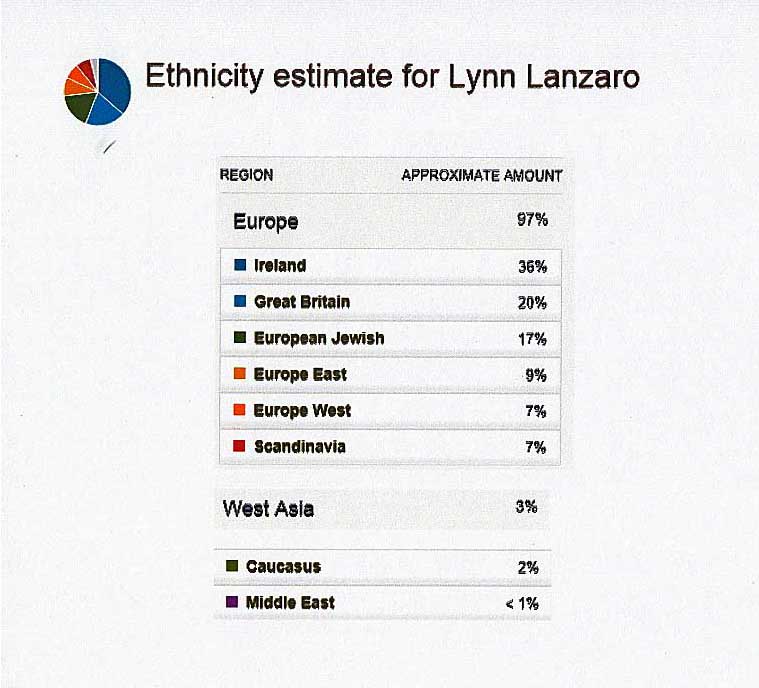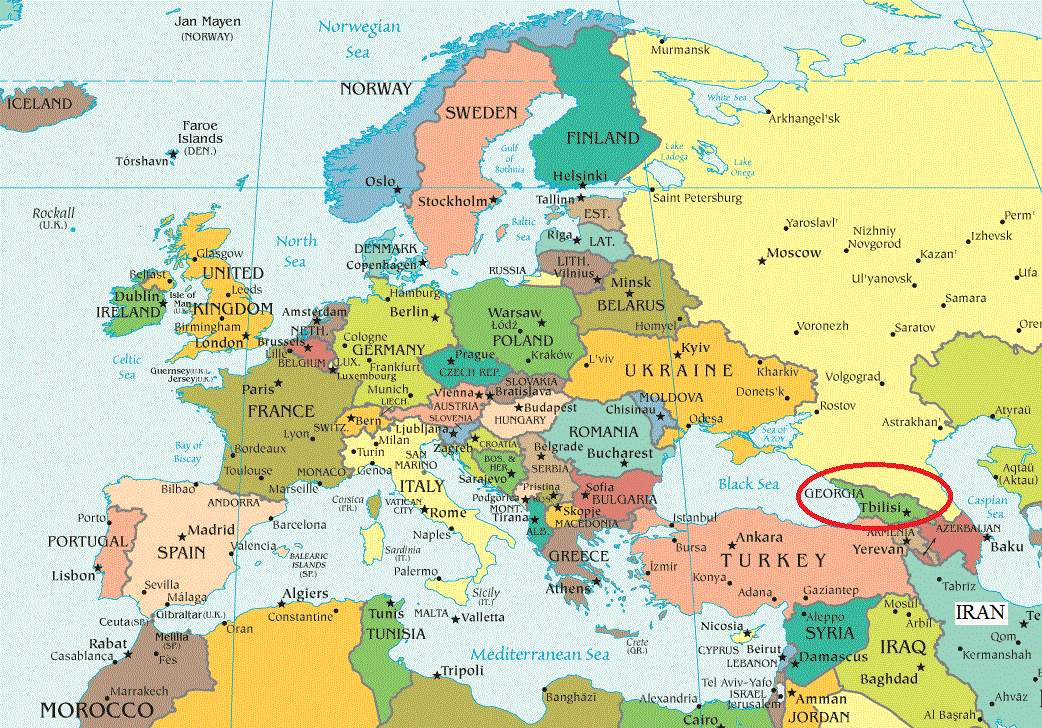LYNN's ANCESTRY.COM DNA ANALYSIS

The results of my Genetic Ethnicity DNA test revealed that my ancestry was primarily from Ireland (36%). Pretty obvious considering my Murphy ancestors.
Another 20% was from Great Britain. While this could include England, Wales and Scotland, given their close proximity to Ireland, it could also mean Northern Ireland,
which is part of Great Britain but physically a part of Ireland.
The next largest category is European Jewish (17%). This would be my Bogner ancestors, primarily from Hungary. Another 9% is Eastern Europe, accounted for by my
Dyszkiewicz and Mazurkiewicz Polish ancestors. My German ancestors from Western Europe, the Bittlingmeier, Bauer and Greuter families, represent 7% of my ethnicity.
And if I needed further proof that my Murphy ancestors were descended from the Vikings, there is the 7% Scandinavian (Denmark, Norway and Sweden) ethnic background.
The final 2% from the Caucasus in Western Asia is most probably my Mitochondrial DNA analysis that showed I was descended from my
genetic ancestor, imaginatively named Xenia, described in detail on the previous page. The Caucasus region is the area northeast of Turkey, between the Black and Caspian seas,
primarily the country of Georgia.

The following is the summary presented to me by Ancestry.com.
Your genetic ethnicity reveals where your ancestors lived hundreds—perhaps even thousands—of years ago. This may update over time as new genetic signatures are discovered.
About British Isles Ethnicity
• Modern Day Location
England, Ireland, Scotland, Wales
• About Your Region
You're from North-Western Europe, an area including the modern-day United Kingdom and Ireland. It is a group of islands separated from France and the rest of continental Europe by the narrow English Channel. It is the rolling, emerald-green hills of Ireland, the craggy, weathered peaks of Wales, the rich history of the city on the Thames, and the deep, mysterious lochs of Scotland.
The history of the region is one of periodic invasions and settlements by various groups including the Angles and Saxons from Germany, the Jutes from Denmark, the Vikings, the Normans from northern France and, of course, the Romans. English, a Germanic language brought by the Angles, is obviously the primary language spoken. But a few of the older languages spoken by the ancient Celts still exist—a rarity in post-Roman Europe.
• Migrations into this region
Despite being a cluster of islands separated from continental Europe, Great Britain and Ireland haven’t been insulated from outsiders. Although they weren’t the first, the Celts from central Europe spread throughout the Northwest Isles about 2500 years ago. Then, as with everywhere else, the Romans came. After the Romans withdrew from the area, tribes from northern Germany and Denmark (the Angles, Saxons and Jutes) came to conquer much of what is now England. About this same time, the mighty Vikings also left their imprint, particularly in southern Scotland, Ireland and western England.
• Migrations from this region
The Great Irish Famine, also called the Potato Famine, was triggered by an outbreak of potato blight, which destroyed potato crops across Europe in the mid 1800s. Already enduring widespread poverty and massive unemployment, Ireland was hit harder than any other nation by the disaster since potatoes were a dietary staple. Ireland lost nearly a quarter of its population. Those who could leave, fled mostly to England, Australia, Canada, and the United States, creating a world-wide Irish diaspora.
About Eastern European Ethnicity
• Modern Day Location
Poland, Greece, Macedonia, Slovakia, Hungary, Croatia, Romania, Bosnia and Herzegovina, Serbia, Ukraine, Lithuania, Latvia, Estonia, Belarus, Moldova, Montenegro, Bulgaria, Belgarus, Kosovo
• About Your Region
Your ethnic profile points to Eastern Europe, which is a region stretching from the Baltic Sea in the north to the Mediterranean in the south. It consists primarily of former "Eastern Bloc" nations that were either aligned with or occupied by the Soviet Union during the Cold War. The Baltic states—Estonia, Latvia, and Lithuania—as well as Belarus and Ukraine were annexed directly into the USSR. While Poland, Slovakia, Hungary, Romania, and Bulgaria were satellite states as members of the Warsaw Pact. Also part of the region are the nations of the former Yugoslavia—Croatia, Bosnia and Herzegovina, Serbia, Montenegro, Kosovo, and Macedonia. Albania and Greece sit at the southern end of the region, bordering the Mediterranean.
The area is considered by many ethnologists to be the homeland of the Slavic people. Most of the nations in the region speak a Slavic language, which spread north and east into Russia and south toward the Balkans in the 5th and 6th centuries.
In the 1400s, the Ottoman Turks conquered the remnants of the Byzantine Empire and throughout the 1500s expanded deep into Eastern Europe, occupying the entire southern region up to Hungary, Romania, and parts of Ukraine. As a result, there are scattered communities of Muslims in the southern countries, although Christianity is prevalent throughout the region.
• Migrations into this region
After the Last Glacial Period 15,000 years ago, populations expanded onto the eastern European plain from the Balkans and Blacks Sea as ice and tundra retreated. These Eastern Europeans were the first of the Neolithic farming culture that entered the Balkans about 9,000 years ago from the Middle East. In fact, individuals from southeastern Europe have inherited a higher proportion of Middle Eastern ancestry than other European individuals. About 2,000-3,000 years ago, the ancestors of Magyars migrated from the Ural Mountains in Russia toward present-day Hungary. Although they contribute their unique language to the region, their genetic impact may have been small.
• Migrations from this region
About 2,300 years ago, the height of the Eastern European influence may have been the rise of the Greeks and their Hellenistic empire following the death of Alexander the Great. Their empire encompassed Italy, Turkey and even stretched all the way to northern India. Among the southeastern populations, Greeks in particular share elevated ancestry with the Middle East, potentially due to relatively recent migrations.
About Persian/Turkish/Caucasus Ethnicity
• Modern Day Location
Georgia, Armenia, Iran, Turkey, Azerbaijan
• About Your Region
Your genetic ethnicity indicates ancestry in the Caucasus region. It extends from the Anatolian Peninsula and the nation of Turkey, bordered by the Mediterranean Sea, along the Caucasus Mountains, which form its northern boundary against Southwestern Russia. Here the nations of Georgia, Armenia, and Azerbaijan are nestled in the highlands between the Black and Caspian Seas. Turning southeast, it encompasses Iran, all the way to the Persian Gulf and Arabian Sea.
It has been the homeland of some of the world's most famous civilizations and empires. Cyrus the Great expanded his territories from his home in Iran to create the powerful Persian Empire, the largest in the world to that point. Known for his religious and cultural tolerance, he freed the Jews from slavery to the Babylonians. His descendants, Darius and Xerxes, famously battled the Greeks at Thermopylae, Salamis, and Marathon during the Greco-Persian wars.
Turkey, in particular, has historically been at the crossroads of Eastern and Western cultures, beginning with the famous Trojan war as told by Homer, when Mycenaean Greeks laid siege to the ancient Lydian city of Troy, which was most likely part of the Hittite Empire. The Roman Empire, ruling from Constantinople, spread Christianity and Greco-Roman culture throughout Anatolia. The arrival of the Turkic peoples from central Asia brought with them the Turkish language and Islam. Their eventual conquest of the Byzantine Empire and its territories in the "Holy Lands" of the Levant were the catalyst of the first Crusades.
• Migrations into this region
About 45,000 years ago, the modern humans first occupied the Caucasus Mountains and surrounding region from a source in the Middle East and continued to serve as a region for migrations throughout history. This was particularly evident during the Neolithic period when farming spread to the Caucasus Mountains and later when Jewish populations also moved north into the region. Additional evidence suggests that 800 years ago, Mongols also invaded the Caucasus area leaving descendants in populations like the Nogay, who carry the 'Genghis Khan' genetic signature.
• Migrations from this region
Despite their intermediate position between Eastern Europe and the Middle East, Caucasian populations seem to have rarely been a thoroughfare for migration. Although the Caucasus Mountains have long been a proposed route for the early agriculturalists to settle to Eastern Europe 8,000 years ago, current genetic data indicate Caucasians and Eastern Europeans have remained relatively isolated.
About Scandinavian Ethnicity
• Modern Day Location
Norway, Sweden, Denmark
• About Your Region
Looks like you may have some Viking blood in you. Your genetic ethnicity ties you to Scandinavia, which includes the modern-day nations of Norway, Sweden, and Denmark. While the Vikings were feared by the coastal towns of medieval Europe as seaborne raiders and violent pillagers, they were also well-travelled merchants and ambitious explorers. They raided the Mediterranean coast of Africa, settled areas as far south as the Black Sea, and traded with the Byzantine Empire. And it was a Norse sailor, Leif Ericson, who is credited with being the first European to travel to North America—500 years before Columbus.
• Migrations into this region
As the glaciers retreated from Northern Europe, roaming groups of hunter-gatherers from Southern Europe followed reindeer herds inland and marine resources along the Scandinavian coast. Neolithic farmers eventually settled the region beginning about 6,000 years ago. However, the tradition of hunting and reindeer-herding remains among the Sami people of northern Scandinavia. The Sami formerly occupied much of northern Scandinavia and Russia, and likely had connections with the Volga-Ural region (where there are other languages similar to Finnish and Sami).
• Migrations from this region
The rise of the Viking culture spread Scandinavian ancestry far throughout Europe. Their earliest coastal voyages took them to Scotland, northeastern England and established the settlement of Dublin, Ireland. As their power continued to grow, the Vikings spread farther afield, down the Volga River in Russia, to the coast of France and Spain. But perhaps their most famous accomplishments were the oceanic voyages across the Atlantic, establishing villages in Iceland and Greenland and exploring the northern coast of Canada. Few, if any of the early Scandinavian settlers, are thought to have survived in the Americas. However, Iceland remains a flourishing post of Scandinavian language and culture.